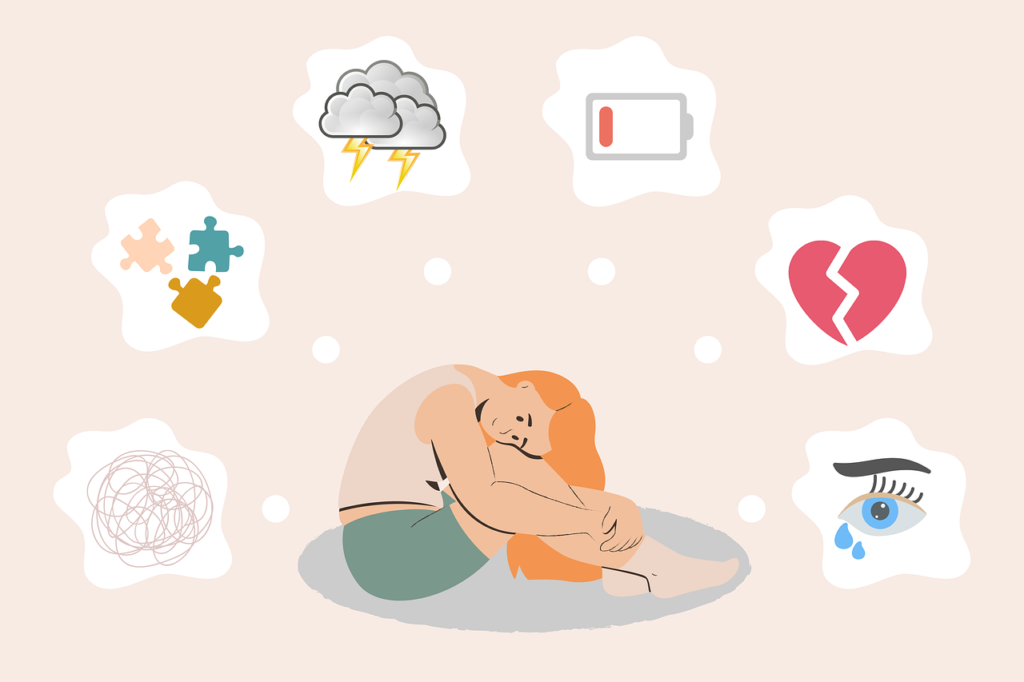3️⃣ Use Self-Discovery as a Healing Tool

Discover the Power
of Self-Understanding
Most people think mental health is about coping mechanisms. Deep breathing, therapy worksheets, mindfulness reminders – strategies to “manage” emotions when they get too intense.
But that’s just survival mode.
True healing starts when you understand yourself on a deeper level. When you stop fighting your brain’s natural tendencies and start working with them. When you learn your patterns, triggers, strengths and blind spots.
🔎 Because here’s the thing -
You can’t heal what you don’t understand.
And in all fairness,
you probably don't know you
as well as you think you do.
The more you know about who you are, the better you can design a life that actually works for you.
 The more you understand your thoughts, behaviors and emotions, the more empowered you become in shaping your wellness journey. But they have to be genuine! They have to be real.
The more you understand your thoughts, behaviors and emotions, the more empowered you become in shaping your wellness journey. But they have to be genuine! They have to be real.
Instead of just reacting to challenges, self-discovery helps you build proactive strategies that align with who you are at your core.
Discovering that person will make all the difference.

🔹 Start Your Journey by Taking the Quiz!
The simple truth is, millions of people are affected by mental disregulaions each year – over 40 million adults in the U.S. alone.
But what if the root cause of your mental health struggles was hidden, right there in plain sight, within your own genes?
🔎 Self-Discovery Is Your Superpower
🧩 You’ve spent years trying to fit into a mold that was never meant for you – pushing yourself to wake up early because “successful people do,” using planners that only seem to gather dust and feeling guilty when rigid routines fall apart.
You’ve forced yourself into habits that don’t align with how your brain operates, leading to cycles of frustration, burnout, and self-doubt. No wonder it’s exhausting.
🧠 What if, instead of changing yourself, you changed how you work with yourself?
Imagine trying to force yourself to sit still and focus for hours when your brain thrives on movement. Instead of battling your natural wiring, what if you incorporated body-doubling – working alongside a friend or virtual coworker – to stay on track?
What if, instead of struggling with traditional to-do lists, you used visual task boards or, my favorite – voice notes to capture your thoughts in a way that makes sense to you?
🌿 Take Sarah, for example – she spent years believing she was lazy because she couldn’t follow strict morning routines. When she finally decided to embrace her neurodivergent strengths, she spoke with her employer and swapped rigid schedules for flexible time-blocking, giving herself permission to start the day at her natural rhythm. The result? Less stress, more productivity and a morning that works for her, not against her.
Or consider Jason, who constantly impulse-spent as a dopamine-driven response to boredom. He beat himself up for his lack of financial discipline – until he understood that his brain craved novelty and reward. Instead of trying to suppress those needs, he set up a “fun fund” and used a reward-based system to manage his finances while still allowing controlled splurges that kept him engaged.
That’s the power of self-discovery. Instead of pushing against the current, you learn how to ride it.
📖 Study: Ryan & Deci, 2000 – “Self-Determination Theory and the Science of Intrinsic Motivation”
Research shows that people are more successful when they build habits based on intrinsic motivation—what feels right—rather than forcing themselves into external expectations. The more you embrace what works for your brain, the more sustainable and fulfilling your life becomes.
Self-Discovery to Heal
💡 Step 1: Identify Your Mental Health Blueprint
Every brain has a unique wiring system and your mental health struggles are often just the side effects of that wiring—not personal failures. The way your brain processes information, emotions and energy impacts everything from your focus and relationships to your sense of stability and well-being.
The key is recognizing these patterns, not as obstacles, but as clues to designing a life that works with your natural rhythm instead of against it.
✅ Do you hyperfocus on interests but struggle with daily tasks?
Meet Alex, a writer with ADHD. He can spend hours researching a niche topic, forgetting to eat or sleep, yet simple tasks like paying bills or doing laundry feel impossible. Instead of forcing himself into traditional productivity methods, Alex uses body-doubling (working alongside a friend) and task-switching (pairing boring tasks with engaging ones) to get through his to-do list without losing momentum.
✅ Do you thrive in deep conversations but get exhausted by small talk?
Lisa, a highly sensitive person, loves discussing philosophy and psychology but dreads casual social gatherings. Instead of forcing herself into draining interactions, she cultivates deeper one-on-one friendships and sets boundaries around social engagements, ensuring she has downtime to recharge.
✅ Do you feel more emotionally intense than others seem to?
Jasmine always felt like she was “too much” because she experiences emotions at full intensity. When she’s happy, she’s ecstatic – when she’s sad, it feels like the world is ending. Instead of suppressing her feelings, she learns emotional regulation techniques, like journaling and sensory grounding, which help her channel that intensity into creativity and connection rather than overwhelm.
✅ Do you need structure, or does routine make you restless?
Michael, who is autistic, finds comfort in structured routines and predictability, while his friend, Jordan, who has ADHD, feels trapped by too much repetition. Michael builds a life with stable schedules and rituals that keep him grounded, while Jordan thrives with flexible routines that allow for novelty. By recognizing what works for them individually, they both create lives that align with their neurodivergent needs.
These patterns aren’t flaws. They’re part of your mental health blueprint—and they hold the key to creating a life that feels balanced.
📖 Study: Aron, 1996 – “The Highly Sensitive Person: A Different Nervous System”
Research shows that some people are neurologically wired to experience the world more deeply, with heightened sensory and emotional responses. When you stop seeing your brain’s unique processing style as a problem and start working with it, you unlock a more fulfilling, sustainable way of living.
Self-Discovery to Heal
🎯 Step 2: Stop Fighting Your Natural Rhythms
Most mental health struggles aren’t just about what you do—they’re about when and how you do it. If you’re constantly fighting against your natural rhythms, it’s no wonder you feel drained, unmotivated, or overwhelmed. Instead of trying to fit into a schedule designed for someone else, what if you built a life that aligns with your energy patterns?
🕰 Are you forcing yourself into a morning routine that drains you?
Take Mia, a neurodivergent entrepreneur. She spent years waking up at 5 AM, convinced it was the only way to be successful—yet she felt groggy, irritable, and sluggish until noon. When she finally embraced her natural night owl tendencies, she shifted her work hours later in the day. The result? More energy, sharper focus, and an easier workflow that actually supports her mental health.
⚡ Are you expecting motivation to appear when your energy cycles don’t support it?
Jared, who has ADHD, kept waiting for motivation to strike before tackling important tasks. But when he paid attention to his energy cycles, he realized his focus peaks in the late afternoon—not the morning when he had been scheduling his hardest work. By shifting his priority tasks to align with his natural highs, he stopped struggling with procrastination and started getting more done without burnout.
🌿 Are you structuring your day in a way that constantly overwhelms you?
Ava, an autistic woman, always felt exhausted by chaotic, unstructured days. She needed predictability but kept trying to “go with the flow” because she thought it would make her more adaptable. When she started building in structured transitions—like a quiet break after social interactions and a clear work-wind-down routine—her anxiety and overstimulation dropped significantly.
✔ If you’re a night owl, stop forcing 5 AM wakeups.
✔ If you thrive on deep work, create space for uninterrupted focus.
✔ If you need movement to regulate your mood, build it into your routine.
💡 You don’t need to be “better at life.” You just need to live life in a way that works for you.
📖 Study: Duffy & Czeisler, 2009 – “The Influence of Chronotype on Mental and Physical Health”
Research shows that forcing yourself into a schedule that doesn’t match your biological rhythms can lead to increased stress, mental fatigue, and even long-term health problems. Understanding your natural cycles isn’t just self-care—it’s essential to sustainable well-being.
Self-Discovery to Heal
🛠 Step 3: Build Systems, Not Willpower
You’ve probably spent years blaming yourself for a lack of discipline or motivation, thinking if you just tried harder, you’d finally get things done. But here’s the truth:
🚨 Willpower is not a long-term strategy.
For neurodivergent minds, relying on sheer willpower is like trying to run a marathon without water. It’s exhausting, unsustainable, and – frankly – not how your brain is wired to work.
Instead of forcing yourself through endless cycles of burnout, it’s time to work with your brain, not against it.
✔ You don’t need to “force” yourself to do things.
✔ You don’t need more motivation.
✔ You don’t need another self-improvement hack.
What you do need are systems that make your life easier.
🎯 If decision fatigue overwhelms you, create a daily checklist.
Take Jordan, who has ADHD. He used to start each day feeling paralyzed by choices – should he answer emails first, work on a project or take care of errands? By the time he decided, half the day was gone. When he implemented a simple morning checklist (1. Make coffee, 2. Check planner, 3. Start deep work), he stopped wasting energy on decisions and started moving through his day with ease. (And he created a new habit – a new pathway, if you will.)
🎯 If you struggle with focus, use environmental triggers to switch gears.
Samantha, who is autistic, found it nearly impossible to shift from relaxation to work mode. Instead of relying on willpower, she started using sensory cues – a specific playlist for focus, a peppermint essential oil for energy and a particular desk setup. Over time, these cues trained her brain to associate those triggers with productivity, making transitions effortless.
🎯 If emotional dysregulation is a challenge, build a grounding routine that you actually enjoy.
Marcus, who experiences RSD (Rejection Sensitive Dysphoria), used to spiral emotionally when faced with criticism. Instead of forcing himself to “just get over it,” he built a grounding system that included a weighted blanket, deep breathing and a short walk routine. The key? He enjoyed these things, so they became second nature, rather than another draining task.
💡 You don’t fail because you’re weak. You struggle because you’re relying on willpower instead of designing a system that supports you.
📖 Study: Baumeister et al., 2007 – “Ego Depletion and the Limits of Willpower”
Research shows that willpower is a finite resource—it drains over time, just like a battery. The more decisions you make, the more depleted you become. That’s why systems, habits, and environmental design are key to long-term success, especially for neurodivergent minds.
Self-Discovery to Heal
🌀 Step 4: Embrace Your Unique Emotional Processing Style
Your emotions aren’t just random – they follow patterns. And once you recognize those patterns, you stop feeling like you’re constantly being blindsided by your own feelings.
For neurodivergent individuals, emotional regulation often looks different from neurotypical norms, but that doesn’t mean it’s wrong. It just means you need to work with your brain, not against it.
✔ Do you experience emotions in waves? Let yourself ride them out instead of resisting.
Take Alex, who has ADHD. When frustration hits, it feels like a tidal wave – overwhelming and impossible to ignore. Instead of forcing himself to “calm down instantly,” he’s learned to ride the wave. He gives himself 10–15 minutes to let the emotion peak and naturally subside, often through listening to music, scribbling his thoughts down or stepping outside barefoot and lifting his face to the sun. Instead of fighting the feeling, he flows with it, reducing emotional exhaustion.
✔ Do you process feelings through movement? Walk, dance or stretch instead of sitting still.
Emma, who is autistic, finds verbal processing difficult. When emotions build up, she doesn’t always have the words to explain what’s wrong. Instead of forcing conversation, she moves. A slow walk, gentle stretching or even fidgeting with a textured object helps her body process emotions before she tries to articulate them.
✔ Do you need to talk things through? Find a trusted friend or therapist who gets it.
Jason, who experiences Rejection Sensitive Dysphoria (RSD), often spirals after receiving constructive criticism at work. Instead of bottling it up, he’s learned to immediately talk it through with a safe person – his friend, James, who understands his neurodivergence or his therapist, if his call can be taken. Verbal processing helps him disarm the intensity of the emotion and move forward without self-destructive thoughts.
Your emotional processing style is not a flaw – it’s a tool. The more you understand it, the more you can work with it instead of feeling trapped by it.
📖 Study: Gross, 1998 – “The Science of Emotion Regulation and Mental Health”
Research shows that how you manage emotions is just as important as the emotions themselves. People who develop strategies that align with their natural processing style experience less emotional burnout and greater overall well-being.
Self-Discovery to Heal
🎨 Step 5: Redefine What "Success"
Looks Like for You
🚨 Newsflash: You don’t have to heal like everyone else.
The self-improvement world loves to push one-size-fits-all success stories. You’ve probably seen them—the perfect 5 AM morning routine, the exact way you should journal, the best meditation technique for everyone. But the reality is, if you’re neurodivergent, forcing yourself into someone else’s method can feel frustrating and exhausting instead of helpful.
Real-Life Examples:
✔ Maybe your meditation is gardening.
Sophie, who has ADHD, struggles with traditional meditation. Sitting still and focusing on her breath makes her more anxious, not less. But when she’s in her garden, hands in the soil, watering plants, feeling the textures—that’s when her mind quiets. Her focus sharpens, her stress melts, and she feels present. Gardening is her meditation.
✔ Maybe your journaling is voice notes on your phone.
Marcus, who is dyslexic, has always struggled with written journaling. Staring at a blank page feels overwhelming. Instead, he records voice notes whenever he needs to process emotions or reflect on his day. Speaking his thoughts aloud gives him clarity, and he can play them back later if he needs to track patterns. Journaling isn’t about writing—it’s about processing in a way that works for him.
✔ Maybe your “routine” is having no routine, because that’s what works for your brain.
Jenna, who is autistic, spent years trying to follow strict routines because she thought that’s what productivity required. But rigid schedules made her feel trapped and stressed. Over time, she realized she thrived with flexible structure—having a list of daily tasks but completing them in whatever order felt right that day. Once she let go of rigid expectations, she felt more productive and less overwhelmed.
💡 Healing isn’t about fitting into a system—it’s about creating one that fits you. Instead of forcing yourself into methods that don’t align with how your brain works, embrace the approaches that do.
📖 Study: Duckworth & Seligman, 2005 – “The Role of Individual Differences in Mental Health Outcomes”
➡Research shows that mental health success isn’t about following one prescribed path—it’s about finding strategies that align with individual strengths and cognitive styles. The best tools are the ones that actually work for you.
Self-Discovery to Heal
🔑 The Bottom Line: Self-Discovery = Freedom
When you truly understand yourself, mental health stops being a battle. You stop feeling like you’re constantly “fixing” yourself and start building a life that aligns with how you actually function.
✔ You stop fighting your brain and start working with it.
✔ You stop feeling broken and start seeing your strengths.
✔ You stop chasing external solutions and start trusting yourself.
🚀 This is where real healing begins.
Bringing It All Together
You don’t have to guess when it comes to your mental health. By understanding your genetics, optimizing your nutrition, and using science-backed holistic strategies, you can take control of your well-being.
👉 Take the Quiz to Identify Key Areas You Should Focus On!
👉 Join The Wellness Collective – Your Community for Personalized Mental Health Solutions!
Your mental wellness journey is unique to YOU. Start exploring these strategies today, and take the next step toward lasting clarity and balance!
✅ [Share This Post on Pinterest] ✅ [Follow Us on Instagram for Daily Tips]
Keep Digging Deeper
Genetics is just the first piece of the puzzle. Once you understand your unique blueprint, the next step is learning how to work with those newfound insights!
🔹 Read: 1️⃣ Get Curious About Their Own Biology – Learn how genetics, nutrition, and neurotransmitters shape mental health.
🔹 Read: 2️⃣ Holistic, Science-Backed Strategies – Go beyond the basics with customized approaches that align with your genes.
🔹 Read: 4️⃣ Take Ownership of Their Mental Health Journey – No more generic advice. No more feeling lost. It’s time to build a plan that actually fits.
Disclaimer: The information and/or products mentioned in these article are provided as information resources only and are not to be used or relied on to diagnose, treat, cure or prevent any disease. The statements made in this article have not been evaluated by the Food and Drug Administration. Any products mentioned are not intended to diagnose, treat, cure, or prevent any disease, but rather to be considered as an informational resource only to encourage critical thinking and personal research. The information in this article is intended for educational purposes only. The information is not intended to replace medical advice offered by licensed medical physicians. Please consult your doctor or health care practitioner for any and all medical advice.
Sign up for our weekly newsletter. it's free!

52 Weeks, 52 Topics! Get Our Latest ‘Stay Well’ Newsletter Every Monday And Start Your Week Off AllNaturWell. A New Tip, A New Study Revealed, A New Product Reviewed. Get It Right To Your Inbox Weekly. No Need To Wait. It’s Free!
